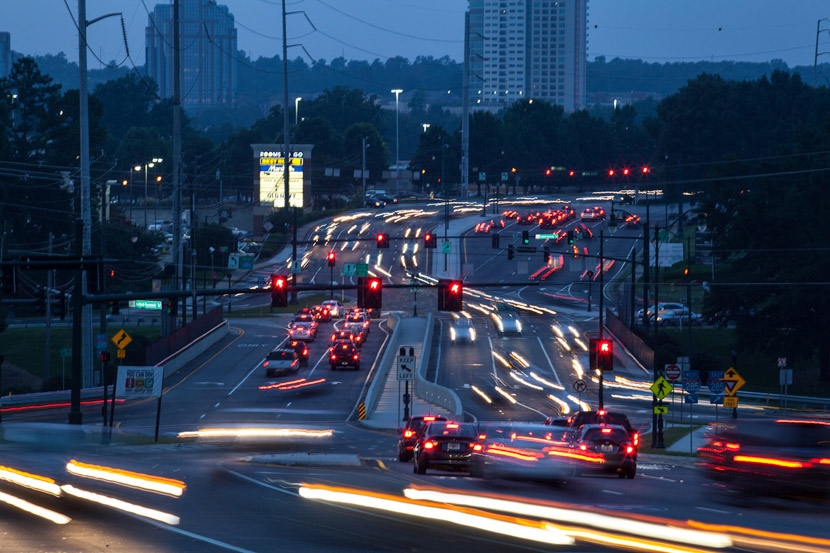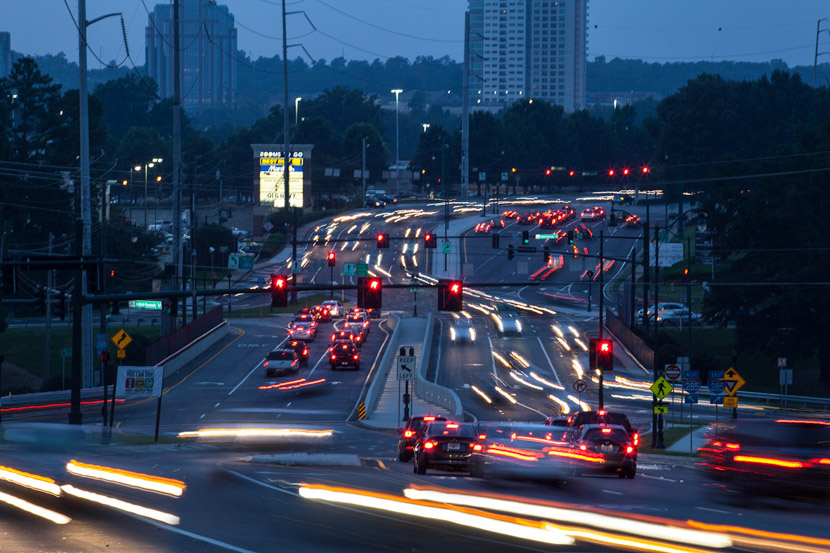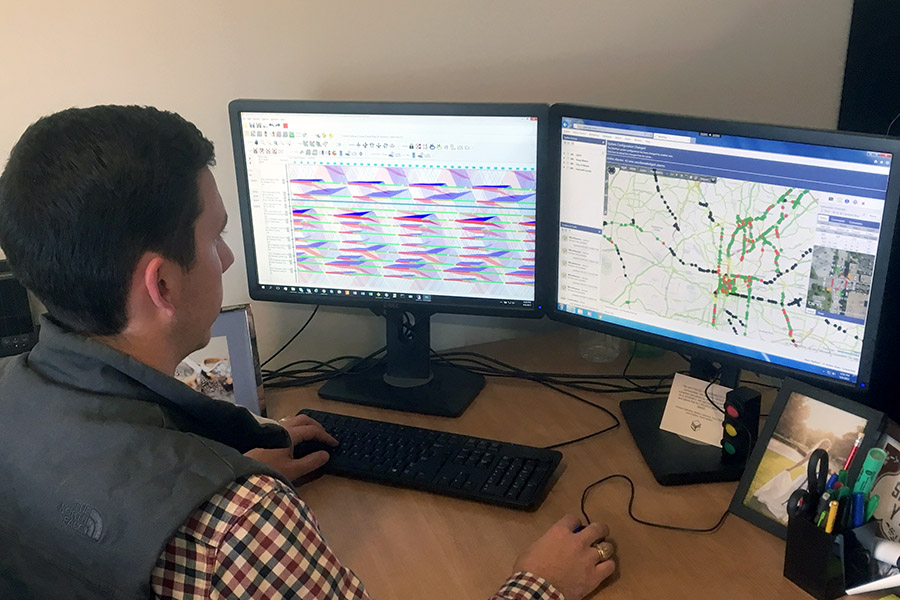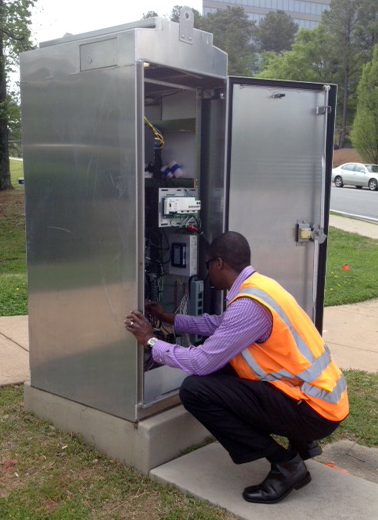
 Traffic moves through the interchange at Ashford-Dunwoody Road and Interstate 285 in Atlanta's Perimeter area. The busy district is one of several areas where the Georgia Department of Transportation and some School of Civil and Environmental Engineering alumni at Kimley-Horn and Associates are using advanced technology and traffic signal timing to maximize the flow of traffic. Known as the Regional Transportation Operations Program, the approach works along congested corridors to optimize signals regardless of city or county jurisdiction, making it a revolutionary approach now being eyed by other states. (Photo Courtesy: Kimley-Horn and Associates) |
The next time you’re sitting at a red light and cursing traffic, remember: it could be significantly worse.
In fact, it would be worse for a number of major commuting corridors in the Atlanta area — if not for the efforts of people like two Georgia Tech civil engineering alumni who are involved in a pacesetting state program to make traffic flow more smoothly.
“Sometimes our joking comment is, we only hear about our job when things are bad, not necessarily when things are good,” said Sean Coleman, a 2004 graduate and a traffic operations and intelligent transportation systems engineer at Kimley-Horn and Associates. “That is one of the difficulties [in what we do], that you're not going to please everybody. You can't. Not every signal can be green at all times.”
Maybe not. But with detailed analysis and studies of a corridor, Coleman and another Tech grad at Kimley-Horn, Alvin James, can adjust traffic signal timings so traffic flows at the absolute optimum. And that means people can get where they’re going just a bit more quickly, even if they do have to sit at a red light from time to time.
 Kimley-Horn engineer Lance Ballard, MSCE 2012, monitors traffic signals in his office after a portion of Interstate 85 collapsed in northeast Atlanta. Ballard and his colleagues worked almost all night with the Georgia Department of Transportation to plan traffic detours and new signal timings after the collapse, preventing a painful situation from becoming even worse. (Photo Courtesy: Kimley-Horn and Associates) |
“Sometimes very quickly we can make a difference for, quite frankly, a lot of people at once,” Coleman said. “If somebody gets home a couple minutes early every single day, and you multiply that by thousands and thousands of people on one road — which ends up being millions of people a day throughout the region — those benefits add up.”
Coleman and James said the program, created six years ago by the Georgia Department of Transportation, has resulted in more than $100 million in time and fuel savings. It also has increased the number of vehicles moving along these corridors at peak times by 20 percent and saved 3.5 million gallons of gas, they said.
It’s also a system that can adapt on the fly to problems in the region’s transportation network — or, as in the case of the Interstate 85 collapse in March, catastrophes. Teams worked through the night after the heavily traveled interstate bridge fell, Coleman said, developing signal timing plans to handle the traffic detoured around the collapse.
“The traffic dispersion from I-85 among the surface street network would’ve been much more painful and created more of a strain on the network if [this program] was not in place,” he said.
 Sean Coleman, a traffic operations and intelligent transportation systems engineer at Kimley-Horn and Associates, works with his colleague Bing Zhang to test traffic signal equipment and signal timing databases in the Kimley-Horn Advanced Signal Timing Lab. Coleman, who earned his civil engineering bachelor's degree in 2004 from Georgia Tech, said his work on the Regional Transportation Operations Program with the Georgia Department of Transportation is rewarding. “Sometimes very quickly we can make a difference for, quite frankly, a lot of people at once.” Zhang earned her master's in civil engineering at Tech in 2014. (Photo Courtesy: Kimley-Horn and Associates) |
Cutting-edge approach
Traffic signal timing may not be new, but the Georgia DOT program that Coleman and James are involved with is near revolutionary. Instead of an individual city or county working to optimize signal timing along one of its busy roads, GDOT’s program optimizes them along an entire corridor, regardless of political boundaries.
It’s an important difference in a city like Atlanta, where a commuting route may cross through several different cities in two or three counties to get people from the suburbs to employment centers and back again.
 Alvin James works on a traffic signal cabinet. James, who is a traffic operations and intelligent transportation systems engineer at Kimley-Horn and Associates, helps move people through some of Atlanta's most heavily traveled corridors as part of the Georgia Department of Transportation's Regional Transportation Operations Program. James, BSCE 2001, MSCE 2004, works with other engineers at Kimley-Horn on several of those roadways, optimizing traffic signal timing along the entire length of a roadway, even when it passes through various cities and counties. (Photo Courtesy: Kimley-Horn and Associates) |
“This is really cutting edge, what the Georgia DOT is doing,” said James, who earned his bachelor’s in civil engineering in 2001 and a master’s in 2004. “This is not like something that you see from another DOT that we just picked up along the way. No, this was something that the DOT really worked hard at for a number of years, to create this program. And it truly is something unique.”
The initiative is called the Regional Transportation Operations Program, and it involves a number of consultant teams working for GDOT on different routes that the agency has designated as regionally significant. Think major state roads like Peachtree Street in Atlanta or State Route 141 that runs from northeast Atlanta up into Gwinnett County and Johns Creek. Altogether, the program involves more than 1,200 traffic signals in the metro Atlanta area.
It also involves more Georgia Tech civil engineers than James and Coleman. Many of the Georgia DOT staff involved in managing and growing what’s known as RTOP are relatively recent graduates.
The project goes beyond just designing the best signal timing for a route: the engineering teams also install and maintain advanced technology to monitor and improve traffic flow, and they actively manage the corridors each day, watching for problems and making adjustments.
“What this program is doing is squeezing every single ounce out of the system,” Coleman said, “which ends up showing a return on investment that is just gigantic. Signal timing can see upwards of [roughly] a 50-to-1 return on investment in terms of what benefits you get when you just optimize what you already have.”
The program has worked so well across the region that Coleman and James are working with GDOT to take the same principles and implement them in Downtown Atlanta and the Perimeter area at the top end of Interstate 285. These congested business districts see tens of thousands of workers pour in each day, deal with periods of heavy pedestrian activity, and then transition to residential or entertainment districts in the evening.
“With [the regional program], you get people into and out of these business districts. Well, what happens when they're in these business districts? Yes, you speed up their first 10 miles, but if that last mile is still a nightmare, it's not a positive experience,” Coleman said. “These traffic operations programs in Downtown, Midtown, and the Perimeter areas are helping improve that last mile for commuters and residents in their vehicles, on their bikes, or on their feet.”
A national model
20 percent more vehicles. $100 million in time and gas. 50-to-1 return on investment. They’re eye-popping numbers that make the approach an easy sell. James said they’re also attracting the attention of other transportation departments around the country who see Georgia DOT’s efforts as a model they can copy.
Did James and Coleman think this is what they would do after they graduated from Georgia Tech? No, they both said. But it’s rewarding work that they were well-prepared to tackle.
“Georgia Tech taught me to be a critical thinker and a problem solver and that's what this is,” Coleman said. “It's problem-solving the traffic signal system and making improvements that impact people's lives.”
“We go through our design and our calculations and we come up with a game plan of what we want to implement, [then] we implement it, and we see almost the immediate impacts on traffic,” James said.
“You can see your job literally making a difference.”
